The U.K. government has just released its AI Opportunities Action Plan and response, which includes 50 recommendations to boost the use of AI. Watch the video for extended highlights, but here’s a brief summary:
Adopting AI talent
Universities will work with industry to create new AI courses and reskill workers for AI-related jobs, with the high-potential individual visa being expanded to attract top talent from abroad.
Availability of data to train AI models
A National Data Library will be established, making high-potential public data sets available to AI researchers and innovators. All public sector projects will be exposed through APIs to the private sector, if deemed appropriate.
Supporting & scaling AI adoption
A good proportion of AI-related projects fail to scale, so the action plan has identified several recommendations to support organizations in the public sector in identifying and scaling opportunities for AI. This includes:
- Appointing AI sector champions in key industries to work with the government in developing AI adoption plans
- A faster, multi-stage AI procurement process to streamline the funding of projects and pilot projects with stricter controls on larger investments.
- The creation of a U.K. Sovereign AI body to partner with private sector companies investing in AI ventures and adopting an AI scan, pilot and scale approach to develop AI applications. Undoubtedly there is an opportunity to use technologies such as task and process mining to highlight areas of improvements that can benefit from AI. For an example, see my blog on task mining within the NHS: Harnessing Process Mining Data to Transform the NHS.
Investments in AI infrastructure
Recommendations include expanding the AI Research Resource (AIRR) to at least 20 times its capacity by 2030. The AIRR's expanded scale would allow it to run more AI research and mission-oriented clusters, each led by a program director for the likes of model training and establishing AI growth zones, with streamlined planning permission approvals to build the necessary data centers to support these investments.
Initiatives already in play include:
- The creation of an AI growth zone in Oxfordshire
- N-scale planning to build its first U.K. data center in Essex as part of a £1.2bn investment to scale up to 50MW in AI and high performance computing capacity
- Vantage building a large campus in Bridgend, Wales, offering up to 150MW in AI compute capacity over the next 10 to 15 years
- In mid-2024, Blackstone announcing its plan to create ten data centers in Northumberland as part of a £10bn investment
- Kyndryl announcing its plan to create up to 1k AI-related jobs in Liverpool over the next three years
- In December 2024, the government greenlighting a previously blocked 140MW Corscale data center in Buckinghamshire
- The government designating data centers as critical infrastructure that will benefit from relaxed planning regulations.
As soon as the individual strategies for the AI Opportunities Action Plan’s recommendations emerge, I'll be providing more detailed analysis.
]]>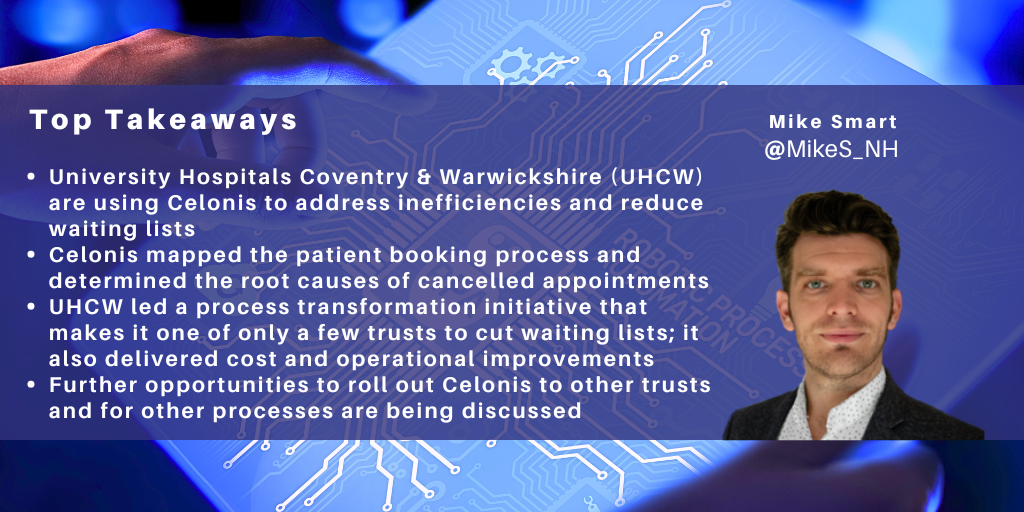
In the U.K., the efficiency of the NHS, and particularly the reduction of waiting lists, continues to be a hot political topic. While promises of cash injections are met with skepticism, a recent event in London showcased how data-driven insights could help improve the NHS’ operational efficiency without the need for major financial outlays. As part of its 22-city tour, process mining vendor Celonis presented its vision for transformative applications within the NHS.
How Celonis can deliver NHS efficiencies
The Celonis process mining platform ingests process data from systems of record, for example CRM systems, and supports organizations in visualizing and analyzing process flows to identify opportunities for process efficiency gains.
A standout example at the event was the use of Celonis at University Hospitals Coventry and Warwickshire (UHCW). Collaborating with IBM, UHCW implemented Celonis to address inefficiencies and reduce waiting lists. While the hospital knew the issues it had, Dr Jacob Koris, one of the NHS’ representatives at the event and a fellow of the NHS’ Get It Right First Time initiatives, stated that the insights from Celonis helped uncover the data to guide process transformation programs. Here are some of the insights that were detected and what the trust has done to address specific issues:
Initial challenges
Challenges included:
- 6.3% of patients did not attend pre-booked treatments
- 21% canceled treatments less than five days before the appointment
- 7% of appointments were canceled by the hospital itself
Data-driven solution
Celonis was deployed, integrating patient booking data to help UHCW understand the underlying reasons why treatment appointments were missed or cancelled, as well as suggesting and monitoring process improvement plans.
The Celonis platform mapped out the process, which included patients initially receiving text message reminders the day or even evening before treatment. These late reminders were identified by the Celonis platform as a possible root cause for late cancellations from patients. UHCW conducted A/B testing to send reminders four days before scheduled treatments compared to the initial one day reminder, with Celonis tracking the testing.
This change reduced missed appointments from 10% to 4% and improved proactive communication from patients
Impact
The improved appointment management allowed the hospital to reallocate previously vacant slots to other patients.
UHCW reduced its waiting list from 72,000 to 67,000, one of the few trusts to achieve a waiting list reduction in the past year.
UHCW’s success extends beyond reducing missed appointments. For example:
- Cost savings and efficiency:
- £1.4 million in annual benefits were realized from short-term interventions
- 17,000 appointments were released by reducing wastage
- 700 more patients per week were accommodated without increasing staff numbers
- Operational improvements:
- Addressed low-value clinical time use caused by inappropriate referrals
- Enhanced hospital productivity by reducing high patient call volumes
- Improved patient experience by decreasing waiting times for treatments.
The broader picture
The success at UHCW has led to the adoption of Celonis by other NHS hospitals, including University Hospital Dorset and Dorset County Hospital. These hospitals are also seeing significant benefits. University Hospital Dorset achieved an annualized benefit of £1.8m, while Dorset County Hospital reported an annualized benefit of £1.1m.
IBM is further supporting these hospitals by deploying Watsonx GenAI in PoCs to enhance patient issue coding and automate the validation of clinical letters, reducing the need for human intervention at the hospitals.
Despite these successes, some NHS trusts and hospitals remain cautious due to past experiences with IT projects that promised but failed to deliver significant improvements. However, the tangible benefits realized by UHCW and other hospitals demonstrate the potential of tools like Celonis to not only replicate existing wins but also uncover new efficiencies.
For example, speaking to IBM at the event, the possibility of gainshare or other rewards-based contracting appeared to be a possibility as incentives for other hospitals. Also, at IBM’s recent partner event focused on GenAI, the company demonstrated a number of outcome-based contracts with other clients focused on process transformation using GenAI technologies.
Future use cases discussed by Dr Jacob Koris at the Celonis event include:
- Reducing the need for multiple hospital visits by scheduling all necessary tests on the same day
- Coordinating appointments for patients and their dependents to occur within the same appointment window.
Conclusion
The Celonis event in London highlighted how data-driven process improvements can help the NHS tackle long-standing issues such as waiting lists without the need for significant additional funding. And while the savings made do not go very far in terms of reducing the overall funding gap, the potential impact for more hospitals and more use cases leveraging technologies such as Celonis to help address inefficiencies is clear.
]]>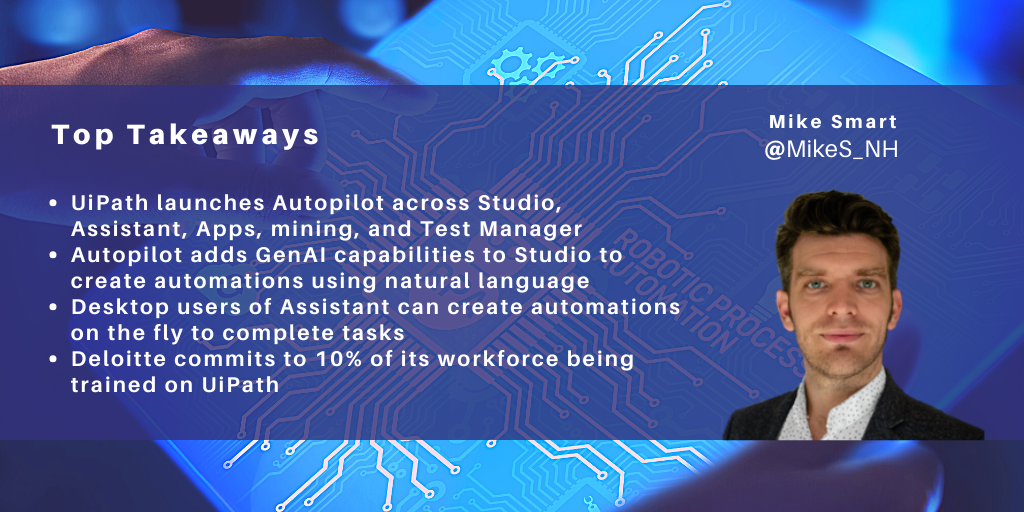
NelsonHall recently attended UiPath’s Forward VI event in Las Vegas, at which the company launched its Autopilot capabilities. While the company launched Autopilot across all its platform components, including Studio, Assistant, Apps, mining, and Test Manager, this blog focuses on its use within Studio and Assistant.
Autopilot for Studio
A constant inhibitor to automation has been the capacity of organizations to build the automations. In the early days, automation relied on skilled developers writing code to build the automation. Platform vendors such as UiPath sought to tackle this inhibitor with the launch of low- and no-code IDEs such as UiPath Studio. However, while that development launched this current wave of automation, companies were still hamstrung by the number of employees trained on these platforms who were able to deliver these results.
Seeking to increase the number of employees that could develop automations, each of the platform vendors focused on increasing support for citizen developers, with UiPath launching StudioX as a simplified version of Studio; indeed, at Forward VI, Deloitte announced that it is committing to having 10% of its 415k employees trained on UiPath as part of a citizen developer drive.
Still, these efforts have not been enough to overcome the capacity issues within clients. To address these issues, UiPath has launched Autopilot for Studio, embedding the capability for users to write requirements for bots in natural language text, from which Autopilot then generates an automation in Studio.
This will not only support citizen developers; experienced developers are often handed bots from citizen developers to ensure the bot is enterprise-grade. With Autopilot, we can expect that the quality of the citizen-developed bot is increased. The demonstrations of Autopilot at the event showed faster bot development than the typical automation developer.
Autopilot for Assistant
On the second day of Forward VI, we also saw a demo of Autopilot for Assistant. Assistant is the interface that lets desktop users see and run all the automations. For the most part, this interface has been selecting automations to run from a list of bots or leveraging the beta of Clipboard AI functionality to quickly and automatically copy information from one interface or image into fields within applications.
With the launch of Autopilot for Assistant, users can now interact through natural language with the interface. This chat interface allows Autopilot to find bots that can answer users’ requests and run desktop automations live on the machine.
Importantly, this is not where the magic ends: if a user asks for something that cannot be completed using existing bots, Autopilot can use the same intelligence used in Autopilot for Studio to create bots that can leverage connectors within Autopilot for Studio to accomplish the task, prompting the human user for confirmation along the way. If the process is successful and the user believes that this automation would be useful, they may add this to the automation hub along with an automatically generated description of the process and the steps performed so that developers can perform any ‘last mile’ work to build the bot, which can be referenced in the future.
In the demo, we saw Assistant being asked to connect with a specific person on LinkedIn. Autopilot interpreted the request, launched a browser, searched for the person, and before requesting the connection, asked the user to confirm the action. In this manner, desktop automation through UiPath assistant is less hamstrung by developers or even citizen developers.
How these developments compare to the competition
UiPath isn’t the first automation platform provider to launch a copilot for their IDEs: in May this year we saw Automation Anywhere launch its copilot capabilities, and last month, Microsoft showed its copilot for Power Automate; both strive to offer bot generation through natural language.
Where UiPath is ahead of the competition is in its secondary use case above, building bots on the fly to support digital assistants. This capability could not only boost the capability and quality of citizen developers, but reduce the need for them entirely.
Another difference we see with these offerings is their pervasiveness, with UiPath launching variants of its copilot across each platform component, including document understanding, test automation, apps, and mining.
UiPath also shared a vision for the future that we did not hear from the competition: using these generative AI capabilities to build auto-healing robots; i.e. automatically fixing aspects that have broken using bot descriptions and the AI behind Autopilot, so reducing the ongoing management cost of bots.
]]>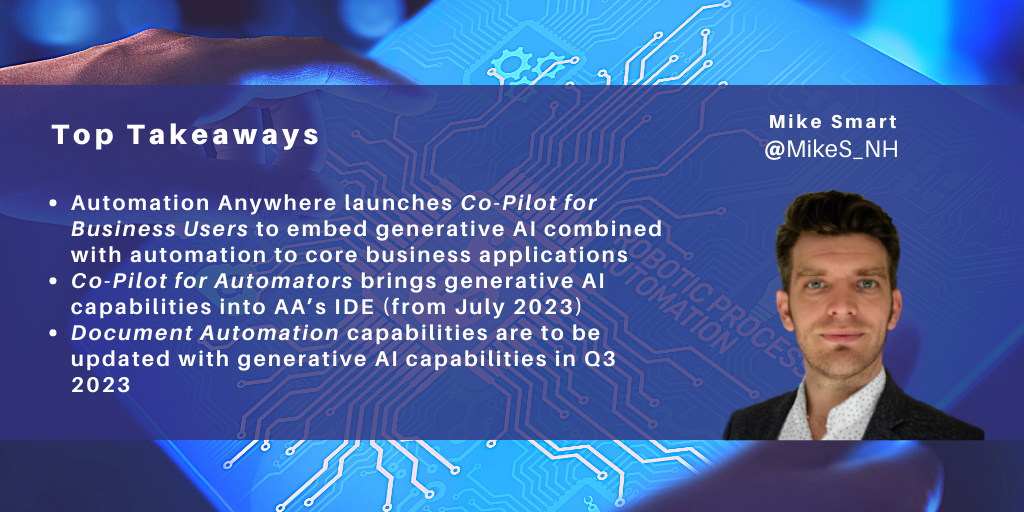
Automation Anywhere recently announced new capabilities for its platform powered by generative AI: Automation Co-Pilot for Business Users and for Automators, plus Document Automation. Here I take a look at these new capabilities and how they compare with those of other providers, and consider the wider implications of generative AI solutions for automation developers.
Automation Co-Pilot for Business Users
This is an update to Automation Co-Pilot AARI launched in October 2022, leveraging generative AI capabilities in automation assistants that can be embedded into business applications.
In the use case shown by Automation Anywhere, a doctor uses Co-Pilot to retrieve patient records and lab results, extracting data from pdf lab results which the doctor can validate, and then uses GPT to generate a summary of the information and editable next-action recommendations:
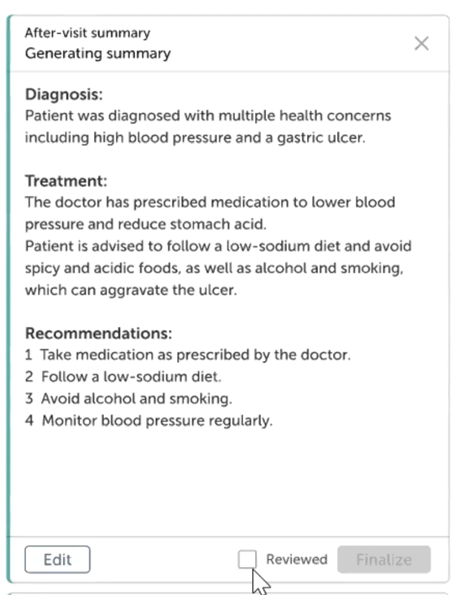
For this solution, Co-Pilot was configured with Process Composer to add the generative AI solution, select the AI model and enter the prompt for the AI. These solutions can leverage generative AI from Microsoft Azure OpenAI, Google Vertex AI (below), Amazon Bedrock, and Nvidia NeMo.
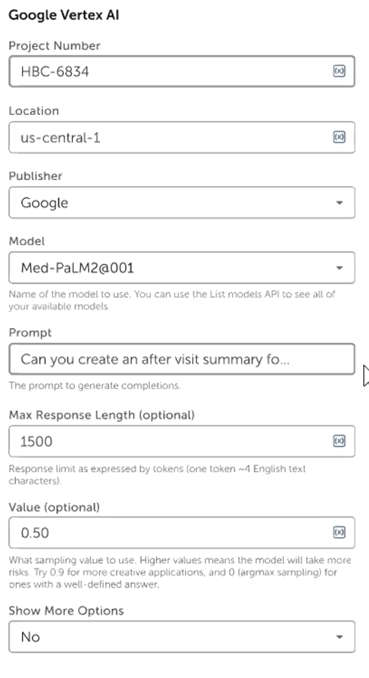
Automation Co-Pilot for Business Users is now available under a ‘bring your own license’ (BYOL) model, with Amazon Bedrock support added in Q2.
Automation Co-Pilot for Automators
Automation CoPilot for Automators aims to support automation designers in building bots by embedding Co-Pilot into the IDE. Using natural language text, users can ask the co-pilot to enter bot requirements which the co-pilot then uses to generate the skeleton of an automation flow in the designer. Users can then continue the chat with Co-Pilot to update this flow.
Following the automation skeleton's generation, Co-Pilot prompts the user to confirm whether the generated automation matched requirements as part of reinforcement learning.
Automation Co-Pilot for Automators will be available for preview in July 2023, with pricing and packaging to be announced.
Document Automation
The third new capability announced is generative AI large language models to analyze, extract, and summarize information as part of Automation Anywhere’s document automation capabilities.
The company states that large language models with minimal customization can read through large documents to find specific clauses or for a general understanding of unstructured documents.
Generative AI for Document Automation is expected to launch in Q3 2023. The company is evaluating different generative AI solutions and models, as these will be offered as an embedded solution rather than BYOL.
How does this compare with other providers?
Generative AI is undoubtedly a hot topic inside and outside the automation space, and the two big themes have been connecting to these large language models within automations and using these models for ‘automating automation’.
In the last month, we’ve seen UiPath going down similar paths with the public preview of its connectors to OpenAI and Azure OpenAI and its Clipboard AI offering which uses generative AI solutions to quickly copy information between applications.
There has also been a lot of news related to code generation, including automation code, using these large language models. These have tended to be focused on generating Python code which can then be imported into automation IDEs rather than embedded into low-code designers, as shown above with Automation Co-Pilot for Automators.
Automation Anywhere has built data protection, security, and compliance requirements into its generative AI offerings. Much has been said about security concerns with developers using generative AI models, with some organizations such as Apple banning employees from using ChatGPT over fears that IP in these conversations is being used to train the large language models.
With these integrations to third-parties, Automation Anywhere has stated that client data is secure and will not be used to train any shared models.
What will generative AI solutions mean for automation developers?
The generative AI solutions that the Automation Anywhere platform is leveraging can be very impressive and the natural question following the Automation Co-Pilot for Automators example is whether the automation space still requires developers.
To that question, NelsonHall answers yes.
Generative AI, similar to low/no code IDEs, is opening up the ability to develop automations for more business users, requiring much less intensive coding or development experience than the old IDEs from several years ago. These advances have mainly been feathers in automation developers’ caps as well as allowing citizen developers to build an automation skeleton quickly. While expanding developer resources to encompass business users who know the process can certainly help in the development of automations, early attempts at this have run into pitfalls due to poor processes being automated inefficiently, and with little investment to ensure that these automations are shared across the organization relative to a centralized automation CoE.
For larger, more complex automations that offer enterprise-wide impact, skilled automation developers are still required to translate the business requirements into automations to leverage the best-in-class methodologies, AI models, and supporting platforms that can be updated to match changing business requirements. In these situations, process understanding (task and process mining) platforms can be used to more fully understand the process and automatically create automation skeletons requiring last-mile work similar to that when using generative AI.
]]>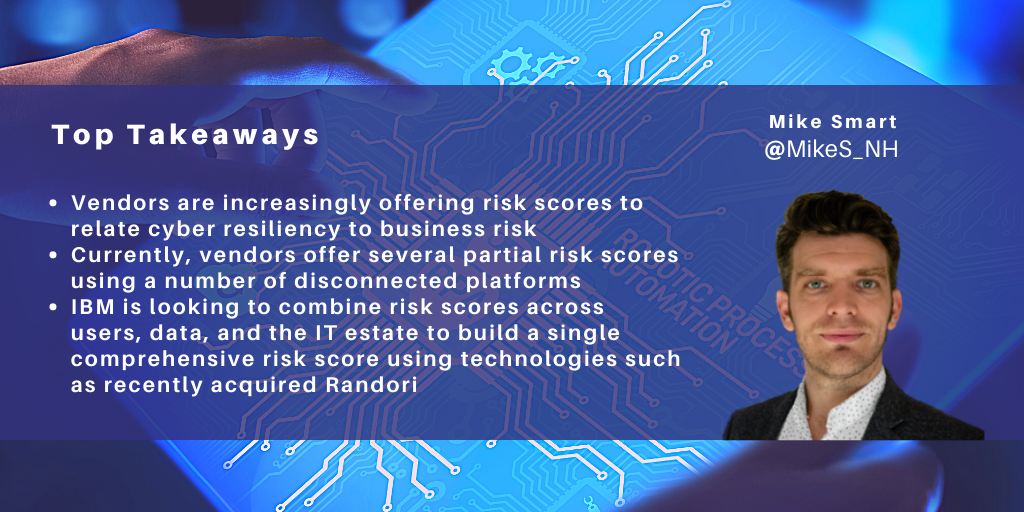
NelsonHall recently attended an IBM Security analyst day in London. This covered recent developments such as IBM’s acquisition of Polar Security on May 16th to support the monitoring of data across hybrid cloud estates, and watsonx developments to support the move away from rule-based security. However, a big focus of the event was the subject of risk.
For the last few years, the conversation around cybersecurity has shifted to risk, highlighting the potential holes within a resiliency posture, for example, and asking questions such as ‘if ransomware were to shut down operations for six hours, what would the implications for the business be?’
IBM and a number of other providers, therefore, have been offering ‘risk scores’ related to aspects of an organization’s IT estate. These include risk scores from IBM’s Risk Quantification Service, IBM Guardium, for risk related to the organization’s data, including its relationship with data security regulations; risk scores from IBM Verify related to particular users; and from recently acquired Randori, the company’s attack surface management solution.
Randori, acquired in June 2022, is a prime example of IBM’s strengths in understanding and reducing risks. Its two offerings, Randori Recon and Randori Attack, aim to discover how organizations are exposed to attackers and provide continuous automated red teaming of the organization’s assets.
After running discovered assets, shadow IT, and misconfigurations through Randori Attack’s red team playbooks, clients are presented with the risks through a patented ’Target Temptation’ model. In this way, organizations can prioritize the targets that are the most susceptible to attack and monitor the change in the level of risk on an ongoing basis.
IBM’s Risk Quantification service uses the NIST-certified FAIR model which decomposes risk into quantifiable components: the frequency at which an event is expected and the magnitude of the loss that is expected per event. In this manner, the service performs a top-level assessment of the client’s controls and vulnerabilities, makes assumptions such as the amount of sensitive information stolen during a breach based on prior examples, and produces a probability of loss and the costs related to that loss, including fines and judgments from regulatory bodies.
It is not the first time we have seen this model and a similar approach being taken by vendors offering cyber resiliency services. One such vendor is Unisys, who in 2018 offered its TrustCheck assessment, which used security data and X-Analytics' software to analyze the client's cyber risk posture and how they associate with financial impacts. These financial impacts were plotted against the threat likelihood of the event.
TrustCheck was used as a driver for the Unisys cybersecurity business; it related the expected loss against guidance to whether the value of securing the client's environment was greater than the cost to remediate a gap, and it conveyed this information to the C-level.
So what is the difference between IBM’s approach to risk and Unisys’ TrustCheck service?
IBM has been approaching its risk qualification from both ends – a bottom-up measuring of user, data, compliance, and the IT estate using platforms such as Guardium, Verify, and now Randori, and a top-down view within its Risk Quantification Service. At the analyst event in London, there was a clear indication that these risk scores would be looking to converge over time to provide a more accurate and consistent view of an organization’s risk. For example, using the outputs from Randori Recon to understand the client’s exposure; Guardium and Polar security to understand what data is being held and where it could travel; and Verify to understand what user access exists. A consistent, accurate view of the client’s resiliency would then be used to drive decision-making.
This convergence of risk scores will not be an immediate development. Randori has just undergone a year of development to integrate its UX into QRadar for a unified experience, and its upcoming development will include being brought into the IBM Security QRadar suite as part of an Attack Surface Management (ASM) service before a consistent risk score service is complete. Likewise, the acquisition of Polar Security needs time to bed in to the data security estate.
NelsonHall does, however, welcome any moves that result in more organizations knowing more about the risks to their business, and the financial risks associated, which has traditionally been a major stumbling block for organizations in understanding what remediation should be taken to increase security postures beyond the baseline of compliance requirements.
]]>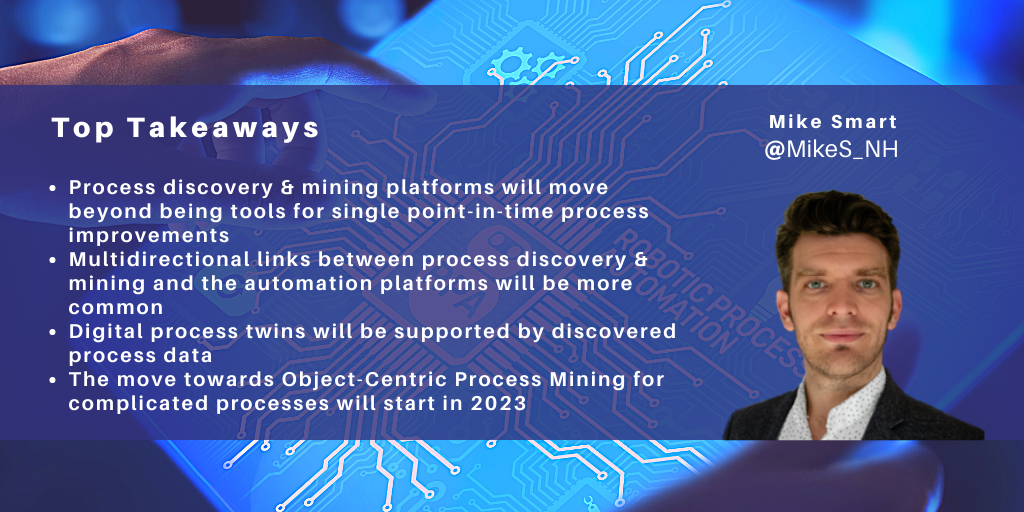
Process discovery and mining platforms, which examine organizations’ process data as part of transformation initiatives, have become an increasingly critical part of process automation and reengineering journeys.
Here I look at what to expect in the process discovery and mining space in 2023 and beyond.
Continuous Monitoring
Traditionally we have seen COEs use process discovery and mining to focus solely on single point-in-time process improvements as part of the transformation journey. Because of this, when an improved process is put into place the focus (and licenses) for the process discovery and mining suites are moved onto the next project.
In 2023, we predict that these solutions will be used to support more process analysis on an ongoing basis, with licenses being used on already reengineered processes to support KPI monitoring and ongoing process improvement. There are certainly features being built into the platforms and pricing models that are reenforcing this move, such as being able to use process discovery platforms to train users on parts of processes that cannot be automated, and unlimited usage licenses that aren’t tied to the amount of users or the amount of process data ingested.
In this way, process discovery and mining solutions can provide a real-time view of actual process performance, augmenting business process management (BPM) platforms.
Automation and Low Code Application Development Links
Process discovery and mining have always been great lead-ins for automation, revealing what processes are in place before automating them; however, that connection has mainly been one way, i.e. process discovery and mining platforms sending over the skeletons of a process to automation platforms to build an automation.
In 2023, we see process discovery platforms implementing more functionality in the reverse direction to take automation logs from the automation tools back into the discovered process to track the overall performance of the process on an ongoing basis, whether the steps of the process are automated or performed by a human.
Likewise, when a process cannot be fully automated and requires human effort, automation platforms are implementing low code applications to collect the necessary information. We envisage the process discovery and mining platforms not only building skeletons of the processes for automation, but also building suggestions from low code applications.
Digital Process Twins
Usually when we refer to digital twins we are talking about a digital representation of a manual process enabled by IoT as part of industry 4.0. However, at the end of last year, we saw one or two vendors moving towards the creation of digital process twins for business operations.
The digital process twin is the culmination of continuous monitoring of both a process and its automation. Using these features, process understanding solutions can be the future of BPM, providing real-time tracking of the performance of a process, and they can enable opportunities like preventative maintenance, leveraging root cause analysis to find when a process is showing signs that it is straying from the target model.
Object-Centric Process Mining
Traditional process mining ascribes a single case notation for every step of the process, but this isn’t the best fit for every process.
For example, in car manufacturing, the production of a car could be held up by the materials for the glass in the windows if single case notation is used. A car manufacturer will not be ascribing the same case notation for silicon arriving at the factory to the car that will eventually be fitted with windows made from that silicon consignment.
In object-centric process mining (OCPM) you would not use a single case notation as the only linking piece in a process. Instead, the case notation ceases to be the be-all-and-end-all of the process and each object, each aspect of the process, is tracked individually, with its own attributes, as part of a whole process.
The object-centric process could then, in the car example, relate case numbers from user issues to the vehicle, to the order they placed, to the windscreen, and to the delivery of silicon.
Such OCPM will expand the usefulness of process discovery and mining from processes that are fairly simple and related to a single case, such as a ticket number on an email, to a more complete view of the process.
***
In this quick look at the future of process discovery and mining, we acknowledge that the features described here may not be the core application of these platforms before the end of 2023, as organizations will continue to use existing functionality to target the bulk of legacy processes requiring quick fixes to reduce costs and perform one-off improvements to processes.
]]>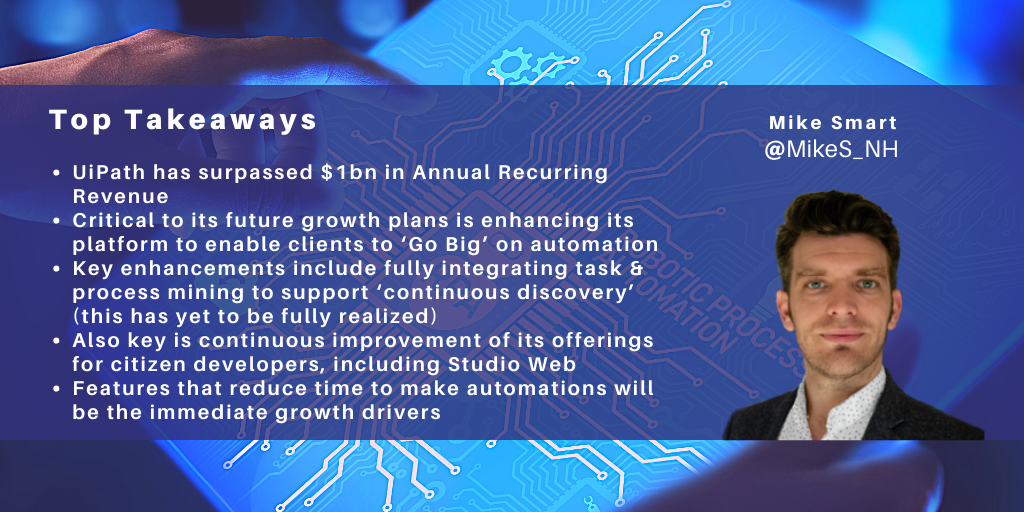
NelsonHall recently attended UiPath’s Forward V event in Las Vegas. The company has recently passed $1bn in Annual Recurring Revenue (ARR), up 44% y/y, enabled through its base of 10.5k clients. This includes some very large clients such as Generali, and, similar to the other tier 1 automation platform providers, an exceptionally long tail of clients with <10 bots. UiPath’s messaging focused on how enhancements to its platform will enable clients to ‘Go Big’ on automation and reach the scale of Generali. This will be critical to UiPath’s long-term growth plans.
Continuous discovery with task & process mining
As such, some of the announcements during the event focused on what UiPath calls ‘continuous discovery’. While the company gained task and process mining capabilities through the acquisitions of ProcessGold and StepShot in 2019 (see the Forward III event blog), Chief Marketing Officer Bobby Patrick stated that back then the end-to-end nature of the platform was mostly ‘on paper’ and not in production, as these components had not been fully integrated. The company now states that the platform is fully integrated, allowing users to help clients discover the as-is state of processes, take actions to optimize and automate them, and then continuously monitor them for ongoing improvement.
What, to some degree, still remains on paper is being able to harness the joint capabilities of task mining and process mining to offer a fuller definition of long complicated processes; currently, UiPath has just a few dozen clients using both components. The general feedback from clients at the event was that these components are not being used in a ‘continuous discovery’ manner (i.e. continuously assessing a process over time for further opportunities for automation and efficiency gains). Instead, licenses are being cycled round the client organization with different departments receiving a point-in-time assessment of the process. We expect this to remain the case going forward in all but very rare scenarios, until task mining licenses decrease in cost.
Another recent acquisition is Re:infer, which brings communications mining functionality. Unlike task or process mining, Re:Infer’s focus is solely on electronic communications within client organizations. The platform can analyze emails, chat logs, social messages, and more, to create actionable business data and new opportunities for automation using its NLP engine. Then, when building and running automations, this NLP engine can be used on inbound electronic communications to trigger automations within UiPath.
The use of Re:Infer is in its early days within UiPath, being only in private preview, and (somewhat like ProcessGold and SnapShot in 2019) has not been fully integrated into the platform. NelsonHall envisions that as Re:infer becomes more integrated into the general UiPath platform suite, it will have the opportunity to become the main NLP engine; for example, being integrated into task mining to better understand emails and documents that employees are working on.
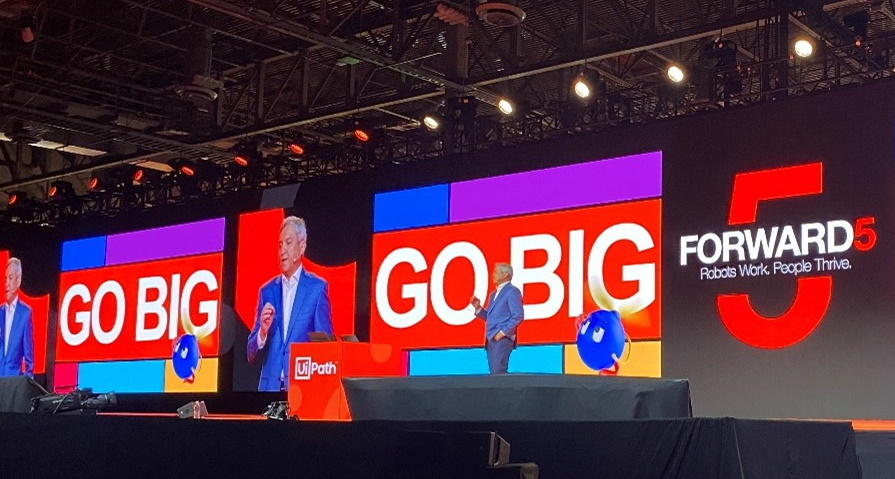
Go Big: theme of UiPath’s Forward V event
Enhancing automation development environments
The UiPath platform offers three development environments: Studio is an advanced product for experienced developers, while Studio X and Studio Web are for less experienced developers.
The most notable recent release is Studio Web, a browser-based automation development environment. The concept is not especially new, mirroring Automation Anywhere’s Automation 360 web IDE, but is a welcome one, especially as the company is continuously improving its offering to citizen developers.
Projects being developed on Studio Web can be edited by users on Studio and Studio X, with a target use case being a citizen developer logging into Studio Web, creating an automation, then (when the automation is ready to be proliferated) it can be sent to Studio for a client’s automation CoE to ensure the robustness of the bot.
Incorporated into Studio Web along with Studio and Studio X are ‘document understanding’ advancements. Along with overall enhancements to the extraction engine to support the likes of signature, barcode, QR code, and improved table extraction, UiPath has added native support for verticalized pre-built models for processing tax, insurance, and transportation documents.
Separate to its automation Studios, UiPath has expanded the capabilities of its Apps component to simplify the creation of lightweight applications, and for the first time, allow for the creation of public-facing apps.
UiPath also announced a partnership with outsystems, another low-code application provider. While UiPath believes its low-code application builder is suitable for a wide variety of applications, it has no plans to support high-complexity systems such as CRM applications. In these use cases, the company believes outsystems can fill that gap.
One app created using UiPath Apps and customizable by clients is Automation Launchpad, a springboard to guide client citizen developers through their company’s automation program; for example, providing information on how they may submit an idea.
Lastly, UiPath has added a connection builder to its Integration Service, its enabler of API automation. Similar to the process and task mining capabilities, Integration Service is now supported across all UiPath components, allowing users to use APIs in addition to the suites’ traditional UX automation capabilities. The connection builder allows clients to build connections to in-house and specialized industry solutions.
Conclusion
These advancements will be critical in enabling more use cases for the platform or allowing for easier identification of automation opportunities and more processes that can be automated. Specifically:
- The process understanding module’s integration will support more organizations opting to discover and understand the processes that are ripe for automation
- Re:infer will, as it integrates into the platform, allow for the detection of electronic conversations that have lots of inefficient back and forth
- Public-facing apps opens up the possibility for organizations to develop lightweight citizen-led ways to interact with customers
- And connection builder allows for more API automation.
These features, along with a change in GTM within sales to support clients who represent the best opportunities to become power users, will be the key to supporting the array of clients that currently don’t take advantage of the wide capabilities of the platform. In speaking with clients at Forward V, each and every one had bandwidth capacity issues with, in most cases, hundreds of opportunities for automation to be identified, but a lack of capacity to automate them all. Therefore, NelsonHall believes the immediate growth drivers will be the features that reduce time to make automations; for example, encouraging more citizen development with Studio Web or within testing automation, and migrating test signatures from QA testing platforms such as HP ALM.
]]>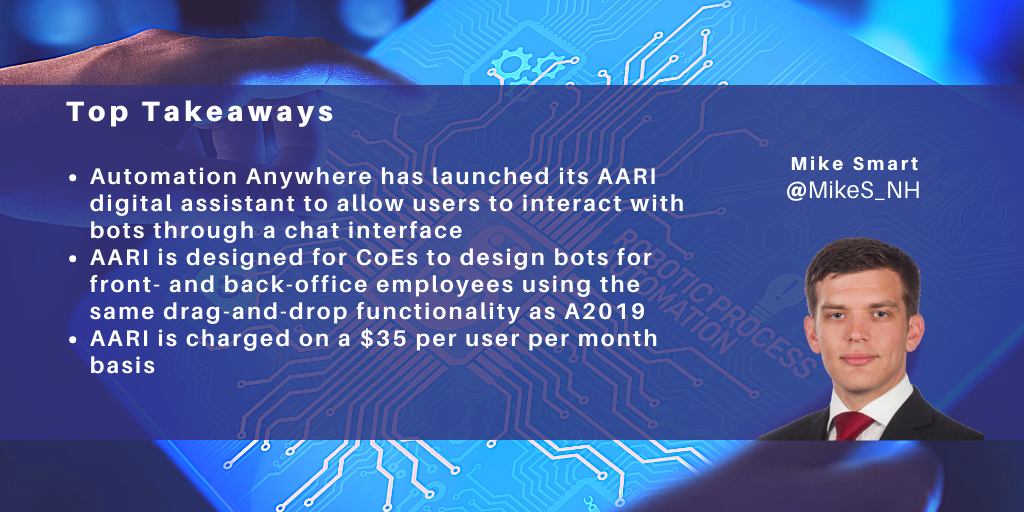
NelsonHall recently attended Automation Anywhere's 2020 innovation day, where the company launched its Automation Anywhere Robotic Interface (AARI) digital assistant focused on making bot usage easier and more accessible to employees.
Automation Anywhere Robotic Interface
AARI “aims to elevate employees' workflows in the same manner as at-home digital assistants such as Alexa and Siri have enhanced their home life” and increase the adoption of RPA in the front and back office.
The AARI application allows users to:
- Launch bots providing integrations to, for example, Salesforce, Google Sheets, and Microsoft Excel through a chat-based interface in addition to via the desktop application, mobile, and web interfaces. Automation Anywhere will also add voice support for accessing bots
- Provide form-style entry into the bot, with the information then disseminated to the client’s business applications
- Manage escalation scenarios.
Automation Anywhere expects CoEs to use AARI to create attended bots triggered using natural language conversations for workgroups or business users across front and back offices.
For example, in a contact center handling customer loans, once the CoE has established the logic behind loan terms and conditions, the workflow with AARI could be optimized to:
- Collect the customer data from across platforms before the call, and present it in the contact center’s CRM platform of choice (e.g., Salesforce)
- Provide forms during the call for the CX agent to populate with information from the conversation, which can then be used to populate the appropriate platforms, reducing the need for re-entry of information
- Extract unstructured information from emailed PDFs using IQ Bot and run credit checks in the background
- Suggest context-specific next-best actions incorporating business rules
- On a natural language command from the CX agent to AARI, such as ‘send over the new loan terms to this customer,’ use the previously established logic to create a set of terms and conditions and email them to the customer.
Early adopter client examples include:
- Colombian financial services firm Bancolombia using AARI to reduce in-branch wait times. The deployment of AARI was completed in one month and resulted in a $19m reduction in provision costs, 59% reduction in response time, and delivered a 1300% ROI in its first year
- CX BPO firm TaskUs using AARI to improve employee experience along with shorter training cycles and improved agent performance for a San Antonio-based client, resulting in a 20-second reduction in AHT, a 3.4% improvement in CSAT, and 2.7% improvement in call quality.
Interactions with AARI are created using standard drag-and-drop task items from the toolbox and can leverage Automation Anywhere's Discovery Bot and other features. AARI will be charged on a $35 per user per month basis.
How distinctive is the AARI concept?
- UiPath’s Forms feature provides an input form functionality similar to AARI to allow users to design forms for a user to input data, then disseminate the input data across its business applications, but does not allow users to launch bots through a conversational input with a digital assistant
- The NICE Employee Virtual Assistant (NEVA) acts as an automation finder to launch pre-existing processes and conversational AI-based scenarios but lacks form-style entry
- In the front office space, the use of bots to integrate platforms to reduce data entry and swivel chair activities is not new. Many of the CX Services vendors have had this form of capability for some years, in addition to handling escalation scenarios as a hygiene factor. These platforms do not, however, offer the automation capabilities of an RPA implementation. The CX vendors also have roadmaps to include features such as chatbots to capture sensitive information and assess the customer's tone to provide answers tailored to their emotional response.
Automation Anywhere differs in bringing together the form data entry capabilities of the RPA providers and CX vendors, and the more niche ability to interact with bots through more conversational means.
]]>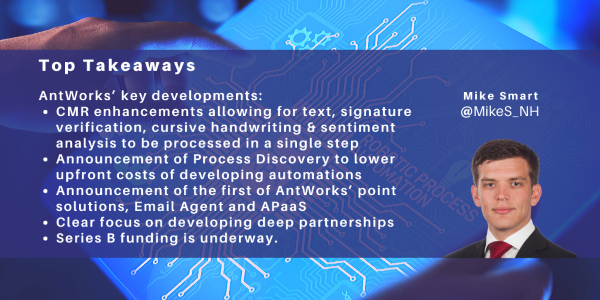
Last week, NelsonHall attended ANTENNA2020, AntWorks’ yearly analyst retreat. AntWorks has made considerable progress since its last analyst retreat, experiencing considerable growth (estimated at ~260%) in the three quarters ending January 2020, and employing 604 personnel at the end of this period.
By geography, AntWorks’ most successful geography remains APAC, closely followed by the Americas, with AntWorks having an increasingly balanced presence across APAC, the Americas, and EMEA. By sector, AntWorks’ client base remains largely centered on BFSI and healthcare, which together account for ~70% of revenues.
The company’s success continues to be based on its ability to curate unstructured data, with all its clients using its Cognitive Machine Reading (CMR) platform and only 20% using its wider “RPA” functionality. Accordingly, AntWorks is continuing to strengthen its document curation functionality while starting to build point solutions and building depth into its partnerships and marketing.
Ongoing Strengthening of Document Curation Functionality
The company is aiming to “go deep” rather than “shallow and wide” with its customers and cites the example of one client which started with one unstructured document use case and has over the past year introduced an additional ten unstructured document use cases resulting in revenues of $2.5m.
Accordingly, the company continues to strengthen its document curation capability, and recent CMR enhancements include signature verification, cursive handwriting, language extension, sentiment analysis, and hybrid processing. The signature verification functionality can be used to detect the presence of a signature in a document and verify it against signatures held centrally or on other documents and is particularly applicable for use in KYC and fraud avoidance where, for example, a signature on a passport or driving license can be matched with those on submitted applications.
This strategy of the depth of document curation functionality resonated strongly with the clients speaking at the event. In one such case, it was the depth of the platform allowing cursive and text to be analyzed together that led to an early drop out of a number of competitors tasked with building a POC that could extract cursive writing.
AntWorks also continues to extend the range of languages where it can curate documents; currently, 17 languages are supported. The company has changed the learning process for new languages to allow for quicker training on new languages, with support for Mandarin and Arabic available soon.
Hybrid processing enables multi-format documents containing, for example, text, cursive handwriting, and signatures to be processed in a single step.
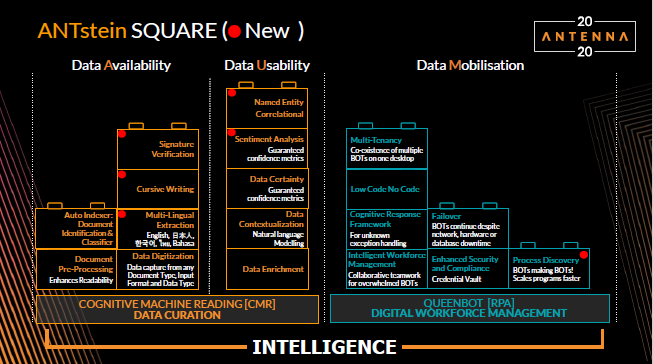
Elsewhere, AntWorks has addressed a number of hygiene factors with QueenBOT, enhancing its business continuity management, auto-scaling, and security. Auto-scaling in QueenBOT to allow bots to switch between processes if one process requires extra assistance to meet SLAs, effectively allowing bots to be “carpenters in the morning and electricians in the evening,” increasing both SLA adherence and bot utilization.
Another key hygiene factor addressed in the past year has been training material. AntWorks began 2019 with a thin training architecture, with just two FTEs supporting the rapidly expanding company; over the past year, the number of FTEs supporting training has grown to 25, supporting the creation of thousands of hours of training material. AntWorks also launched its internship program, starting in India which has added 43 FTEs in 2019. The ambition this year is to go global with this program.
Announcement of Process Discovery, Email Agent & APaaS Offerings
Process discovery is an increasingly important element in intelligent automation, helping to remove the up-front cost involved in scaling use cases by identifying and mapping potential use cases.
AntWorks’ process discovery module enables organizations to both record the keystrokes taken by one or more users against multiple transactions or import keystroke data from third-party process discovery tools. From these recordings, it uses AI to identify the cycles of the process, i.e. the individual transactions, and presents the user with the details of the workflow, which can then be grouped into process steps for ease of use. The process discovery module can also be used to help identify the business rules of the process and assist in semi-automatic creation of the identified automations (aka AutoBOT).
The process discovery module aims to offer ease of use compared to competitive products and can, besides identifying transaction steps, be used to assist organizations in calculating the RoI on business cases and in estimating the proportions of processes that can be automated, though AntWorks is understandably reluctant to underwrite these estimates.
One of the challenges for AntWorks over the coming year is to develop standardized use cases/point solutions based on its technology components, initially in horizontal form, and ultimately verticalized. Two of these just announced are Email Agent and Accounts Payable as-a-Service (APaaS).
Email Agent is a natural progression for AntWorks given its differentiation in curating unstructured documents, built on components from the ANTstein full-stack and packaged for ease of consumption. It is a point solution designed solely to automate email traffic and encompasses ML-based email classification, sentiment analysis to support email prioritization, and extraction of actionable data. Email Agent can also respond contextually via templated static or dynamic content. AntWorks estimates that 40-50 emails are sufficient for training for each use case such as HR-related email.
The next step in the development of Email Agent is the production of verticalized solutions by training the model on specific verticals to understand the front office relations organizations (such as those in the travel industry) have with their clients.
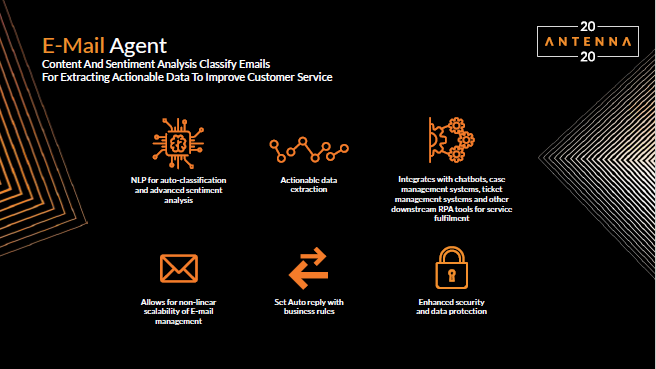
APaaS is a point solution consisting of a pre-trained configuration of CMR to extract relevant information from invoices which can then be API’d into accounting systems such as QuickBooks. Through these point solutions offered on the cloud, AntWorks hopes to open up the potential for the SME market.
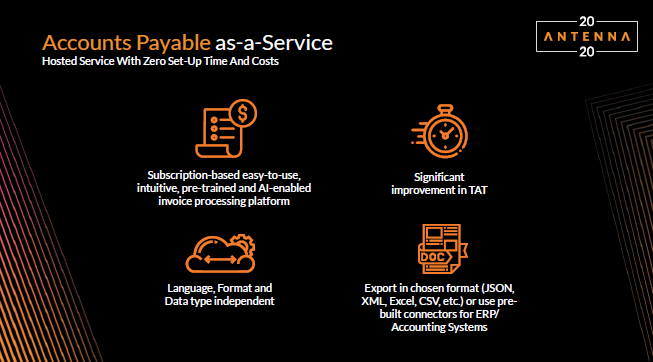
Focusing on Quality of Partnerships, Not Quantity
Movement on AntWorks’ partner ecosystem (now ~66) has been slower than expected, with only a handful of partners added since last year's ANTENNA event, despite its expansion being a priority. Instead, AntWorks has been ensuring that the partnerships it does have and signs are deep and constructive. Examples of these deep partnerships include Bizhub and Accenture, two partners who have been added and that are helping train CMR in Korean and Thai respectively in exchange for some timed exclusivity in those countries.
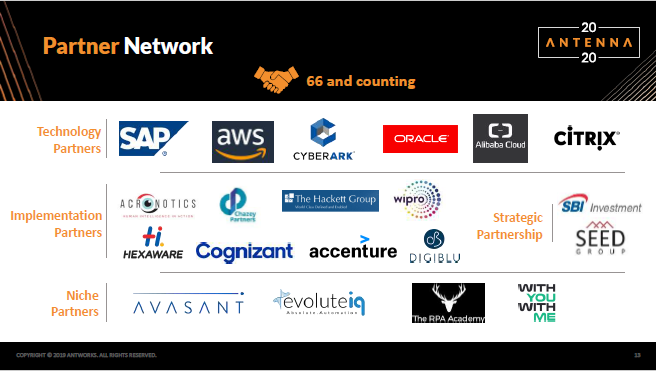
AntWorks is also partnering with SBI Group to penetrate the South East Asia marketplace, with SBI assisting AntWorks in implementing the ability to carry out data extraction in Japanese. Elsewhere, AntWorks has partnered with the SEED Group based in Dubai and chaired by Sheikh Saeed Bin Ahmed Al Maktoum to access the MENA (Middle East & North Africa) region.
New hire Hugo Walkinshaw was brought in to lead the partnership ecosystem very recently, and he has his work cut out for him, as CEO Ash Mehra targets a ratio of direct sales to sales through partners of between 60:40 and 50:50 (an ambitious target from the current 90:10 ratio). The aim is to achieve this through the current strategy of working very closely with partners, signing exclusive partnerships where appropriate, and targeting less mature geographies and emerging use cases, such as IoT, where AntWorks can establish a major presence.
In the coming year, expect AntWorks to add more deep partnerships focused on specific geographic presence in less mature markets and targeted verticals, and possibly with technology players to support future plans for running bots on embedded devices such as ships.
Continuing to Ramp Up Marketing Investment
AntWorks was relatively unknown 18 months ago but has made a major investment in marketing since then. AntWorks attended ~50 major events in 2019, possibly 90 events in total, counting all minor events. However, AntWorks’ approach to events is arguably even more important than the number attended, with the company keen to establish a major presence at each event it attends. AntWorks does not wish to be merely another small booth in the crowd, instead opting for larger spaces in which it can run demos to support the interest in clients and partners.
This appears to have had the desired impact. Overall, AntWorks states that in the past year it has gone from being invited to RFIs/RFPs in 20% of cases to 80% and that it intends to continue to ramp up its marketing budget.
A series B round of funding, currently underway, is targeted on expanding its marketing investments as well as its platform capabilities. Should AntWorks utilize this second round of funding as effectively as its first with SBI Investments 2 years ago, we expect it to act as a springboard for exponential growth and these deep relationships and continue to lead in middle- and back-office intelligent automation use cases with high volumes of complex or hybrid unstructured documents.
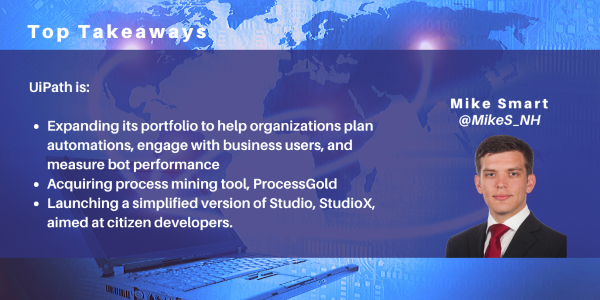
Reboot work was the slogan for UiPath’s recent Forward III partner event, a reference to rethinking the way we work. UiPath’s vision is to elevate employees above repetitive and tedious tasks to a world of creative, fulfilling work. The company’s vision is driven by an automation first mindset, along with the concept of a bot for everyone and human-automation collaboration.
During the event, which attracted ~3K attendees, UiPath referenced ~50 examples of clients at scale, and pointed to a sales pipeline of more than $100m.
Previously, UiPath’s automation process had three phases: Build, Manage, and Run, using Studio, Orchestrator, and Attended and Unattended bots respectively. Their new products extend this process to six phases: Plan, Build, Manage, Run, Engage, and Measure. In this blog, I look at the six phases of the UiPath automation process and at the key automation products at each stage, including new and enhanced products announced at the event.
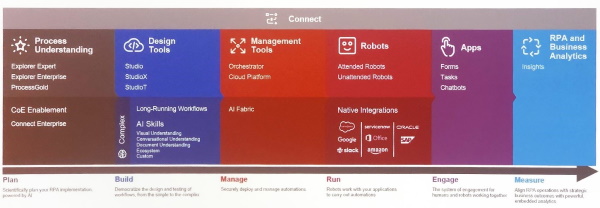
Plan phase (with Explorer Enterprise, Explorer Expert, ProcessGold, and Connected Enterprise)
By introducing the product lines Explorer and Connected Enterprise, UiPath aims to allow RPA developers to have a greater understanding of the processes to be automated when planning RPA development.
Explorer consists of three components, Explorer Enterprise, Explorer Expert, and ProcessGold. Explorer provides new process mapping and mining functionality building on two UiPath acquisitions: the previously announced SnapShot, which now comes under the Explorer Enterprise brand, and the newly announced ProcessGold whose existing clients include Porsche and EY. Both products construct visual process maps in data-driven ways; Explorer Enterprise (SnapShot) does this by observing the steps performed by a user for the process, and ProcessGold does this by mining transaction logs from various systems.
Explorer Enterprise performs task mining, with an agent sitting in the background of a user machine (or set of users’ machines) for 1-2 weeks. Explorer then collects details of the user activities, the effort required, the frequency of the activity, etc.
ProcessGold, on the other hand, monitors transaction logs and, following batch updates and 2 to 3 hours of construction, builds a process flow diagram. These workflow diagrams show the major activities of the process and the time/effort required for each step, which can then be expanded to an individual task level. Additionally, at the activity level, the user has access to activity and edge sliders. The activity slider expands the detail of the activities, and the edge slider expands the number of paths that the logged users take, which can identify users possibly straying from a golden path.
Administrators can then use the data from Explorer Enterprise and/or ProcessGold in Explorer Expert. Explorer Expert allows the admin users to enter deeper organizational insights, and either record a process to build or manually create a golden path workflow. These workflows act as a blueprint to build bots and can be exported to Word documents which can then be used by bot creators.
Connected Enterprise enables an organization to crowdsource ideas for which processes to automate, and aims to simplify the automation and decision-making pipelines for CoEs.
Automation ideas submitted to Connected Enterprise are accompanied by process information from the submitter in the form of nine standard questions, such as how rule-based it is, how likely to change it is, who the owner is, etc. as well as process owners. This information is crunched to produce automation potential and ease of implementation scores to help decide on the priority of the automation idea. These ideas are then curated by admins who can ask the end-user for more information, including an upload of ProcessGold files.
The additions of Explorer and Connected Enterprise allow developers to gain deeper insights into the processes to be automated, and business users to connect with RPA development.
Build phase (with enhanced Studio, plus new StudioX & StudioT)
New components to the build phase include StudioX and StudioT along with a number of enhancements to the existing Studio bot builder.
StudioX is a simplified version of the Studio component which is targeted at citizen developers and regular business users, which UiPath referred to ‘Excel power user level’, to create more simplistic bots as part of a push for citizen developers and a bot for every person.
StudioX simplifies bot development by removing the need for variables, and reduces the number of tasks that can be selected. Bots produced with StudioX can be opened with Studio; however, the reverse may not necessarily be the case depending on the components used in Studio.
The build-a-bot demo session for StudioX focused on using Excel to copy data in and out of HR and finance systems and extracting and renaming files from an Outlook inbox to a folder. Using StudioX in the build-a-bot session was definitely an improvement over Studio for the creation of these simple bots.
StudioT, which is in beta and set to release Q1 2020, will act as a version of Studio focused entirely on testing automation. NelsonHall’s software testing research, including software testing automation, can be found here.
Further key characteristics of the existing build components include:
- Long-running workflows which can suspend a process, send a query to a human while freeing up the bot, and continuing the bot once the human has provided input
- Cloud which has a 1-minute signup for the Community version of the aaS platform and (as of September 2019) has 240k users, up from 167k in June 2019
- Queue triggers which can automatically take action when items are added to the queue
- More advanced debugging with breakpoint and watch panels
- Taxonomy management
- Validation stations.
With the introduction of StudioX, UiPath aims to democratize RPA development to the business users, at least in simple cases; and with long-running workflows, human-bot collaboration no longer requires bots to sit idle, hogging resources while waiting for responses.
Manage phase (with AI Fabric)
The Manage phase now allows users to manage machine learning (ML) models using AI Fabric, an add-on to Studio. It allows users to more easily select ML models, including models created outside of UiPath, and integrate them into a bot. AI Fabric, which was announced in April 2019, has now entered private preview.
Run phase (with enhancements to bots with native integrations)
Improvements to the run components leverage changes across the portfolio of Plan, Build, Manage, Run, Engage, and Measure, in particular for attended bots with Apps (see below). Other new features include:
- Expanding the number of native integrations, for which UiPath and its partners are building 100s of connectors to business applications such as Salesforce and Google to provide functionality including launching bots from the business application. Newer native applications are available via the UiPath Go! Storefront
- A new tray will feature in the next release.
Engage phase (allowing users direct connection to bots with Apps)
Apps act as a direct connection for users to interact with attended bots through the use of forms, tasks, and chatbots. In Studio, developers can add a form with the new form designer to ask for inputs directly from the user. For example, combined with an OCR confidence score, a bot could trigger a form to be filled in should the confidence score of the OCR be substandard due to a low-quality image.
Bots that encounter a need for human intervention through Apps will automatically suspend, add a task to the centralized inbox, and move on to running another job. When a human has completed the required interaction, the job is flagged to be resumed by a bot.
With the addition of Apps, the development required to capture inputs from the business users is minimized to allow for a deeper human-bot connection, reduction of development timelines, and helping to enable the goal of ‘a bot for every person’.
Measure phase (now with Insights to measure bot performance)
Insights expands UiPath’s reporting capabilities. Specifically, Insights features customizable dashboarding facilities for process and bot metrics. Insights also features the ability to send pulses, i.e. notifications, to users on metrics, such as if an SLA falls below a threshold. Dashboards can be filtered on processes and bots and can be shared through a URL or as a manually sent or scheduled PDF update.
What does this mean for the future of UiPath?
While UiPath and its competitors have long-standing partnerships with the likes of Celonis for process mining, the addition of native process mining through the acquisitions of SnapShot and ProcessGold, in addition to the expanded reporting capabilities, position UiPath as more of an end-to-end RPA provider.
With ProcessGold, NelsonHall believes that UiPath will continue the development of Explorer, which could lead to a nirvana state in which a client deploys ProcessGold, ProcessGold maps the processes and identifies areas that are ideal for automation, and Explorer Expert helps the bot creator to design this process by linking directly with Studio. While NelsonHall has had conversations with niche process mining and automation providers that are focusing on developing bots through a combination of transaction logs and recording users, UiPath is currently the best positioned of the big 3 intelligent automation platform providers to invest in this space.
StudioX is a big step towards allowing citizen developers. During our build-a-bot session, it was clear that the simplified version of the platform is more user-friendly, resulting in the NelsonHall team powering ahead of the instructor at points. However, we were somewhat concerned that while StudioX opens up the ability to develop bots to a larger scope of personae, the slight disconnects between Studio and StudioX could lead to users learning StudioX and wanting to leverage activities that are currently restricted to Studio (such as error handling) becoming frustrated. NelsonHall believes that the lines between Studio and StudioX will blur, with StudioX receiving simplified functions currently restricted to Studio, which will enable more bots to be passed between the two personae.
Conclusion
With the announcements at the Forward III event, it is clear that UiPath is enabling organizations to connect the business users directly with automation; be that through citizen developers with StudioX, the Connected Enterprise Hub to forge stronger connections between business users and automation CoEs, Explorer to allow the CoE to have greater understanding of the processes, or Apps to provide direct access to the bot.
This multi-pronged push approach to connect the developer and automation to the business user will certainly reduce frustrations around bot development and reduce the feeling from business users that automation is something that is thrust upon them rather than being part of their organization's journey to a more efficient way of working.
]]>The event, the first under new CMO Riadh Dridi, showcased improvements in the new version of the Automation Anywhere platform around:
- Experience – the most immediate change is in the UI. While prior versions utilized code, workflow, and mixed code/workflow views, the new version features a completely revamped workflow view that simplifies the UX with little coding environment
- Cloud –delivery now utilizes a completely web-based interface, allowing users to sign in and create bots in minutes with zero required installation. This speed of development was demonstrated live on stage with SVP of products Abhijit Kakhandiki successfully racing to create a simple bot against the arrival of an Uber ordered by CEO Mihir Shukla. The bot used in this example was part of Automation Anywhere’s RPA-aaS offering, hosted on Azure leveraging its partnership with Microsoft. Automation Anywhere was also keen to point out the ability to use the platform on-premise or in a private cloud, as is deployed at JP Morgan Chase, the client speaking at the event
- Ecosystem – Automation Anywhere highlighted it has strong and growing ecosystem. With Microsoft, for example, the partnership has been operating for over a year and has so far featured the ability to embed Microsoft’s AI tools into bots, and the above-mentioned Azure partnership. The event featured a demonstration of the integration of Automation Anywhere into Office: a user was able to select and use bots from Excel, as a single joined experience
- Intelligent Automation – in addition to leveraging the ecosystem for its ability to drag and drop third-party AI components, another improvement in A2019 was the integration of the capabilities gained through the Klevops acquisition earlier this year to improve assisted automation capabilities, providing a greater bot and human collaboration across teams and workflows
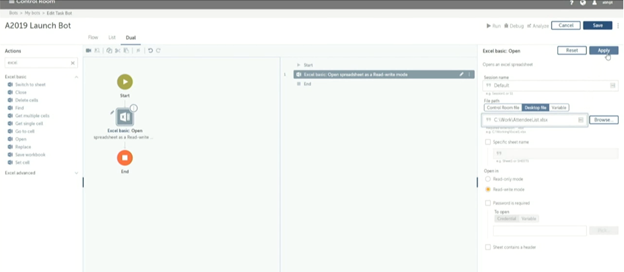
The majority of these enhancements are already analyzed in NelsonHall’s profile of Automation Anywhere’s capabilities as part of the Intelligent Automation Platform NEAT assessment.
Using the above enhancements, Automation Anywhere estimates that whereas previously clients required 3 to 6 months to POC, and a further 6 to 24 months to scale, it now takes 1-4 months to POC and 4-12 months to scale.
Absent from the event were enhancements to the governance procedure of bots, vitally important as the access to build bots increases, and the bot store for which curation could still be an issue.
While the messaging of the event was ‘Anything Else is Legacy’, there were some natural points in which the announcement looks unfinished – the partnership with Office currently only extends to Excel, the rest of the suite will follow, and the Community version of Automation Anywhere, which is how a large proportion of users dip their toes in the water of automation, is set to be updated to match A2019 later in Q4 2019. Likewise, while the improvement to the workflow view is much cleaner, easier to use than competitors, leading to quicker bot development, the competitor platforms more easily handle complex, branching operations. Therefore, while A2019 can be ideal for organizations that are looking to have citizen developers build simple bots, organizations looking to automate more complex workflows should include the competing platforms in shortlisting.
NelsonHall's profile on the Automation Anywhere platform can be found here.
The recent NEAT evaluation of Intelligent Automation Platforms can be found here.
]]>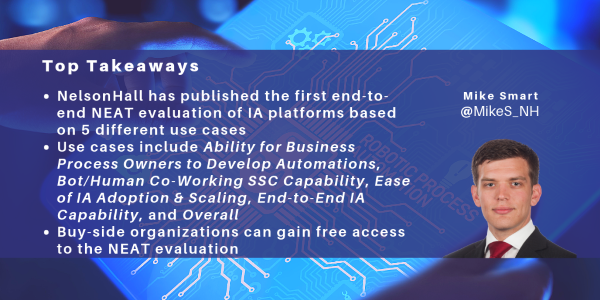
NelsonHall has just launched an industry-first evaluation of Intelligent Automation (IA) platforms, including platforms from Antworks, Automation Anywhere, Blue Prism, Datamatics, IPsoft, Jacada, Kofax, Kryon, Redwood, Softomotive, and UiPath.
As RPA and artificial intelligence converge to address more sophisticated use cases, we at NelsonHall feel it is now time for an evaluation of IA platforms on an end-to-end basis and based on the use cases to which IA platforms will typically be applied. Accordingly, NelsonHall has evaluated IA platforms against five use cases:
- Ability for Business Process Owners to Develop Automations
- Bot/Human Co-Working SSC Capability
- Ease of IA Adoption & Scaling
- End-to-End IA Capability
- Overall.
Ability for Business Process Owners to Develop Automations – as organizations move to a ‘bot for every worker’, platforms must support the business process owners in developing automations rather than select individuals as part of an automation CoE. Capabilities that support business process owners in developing an automation include a strong bot development canvas, a well-populated app/bot store, and process discovery functionality, all in support of speed of implementation.
Bot/Human Co-Working SSC Capability – in addition to traditional unassisted back-office automation and assisted individual automations, bots are increasingly required to provide end-to-end support for large-scale SSC and contact center automation. This increasingly requires bot/human rather than human/bot co-working, with the bot taking the lead in processing SSC transactions, queries and requests. The key capabilities here include conversational intelligence, ability to handle unidentified exceptions, and seamless integration of RPA and machine learning.
End-to-End IA Capability – the ability for a platform to support an automation spanning an end-to-end process, leveraging ML and artificial intelligence, either through native technologies or through partnerships. While many IA implementations remain highly RPA-centric, it is critical for organizations to begin to leverage a wider range of IA technologies if they are to address unstructured document processing and begin to incorporate self-learning in support of exception handling. Key capabilities here include computer vision/NLP, ability to handle unidentified exceptions, and seamless integration of RPA and machine learning in support of accurate document/data capture, reduced error rates, and improved transparency & auditability of operations.
Ease of IA Adoption & Scaling – the ability for organizations to roll out automations at scale. Key criteria here include the ability to leverage the cloud delivery of the IA platform and the strength of the bot orchestration/management platform.
Overall – a composite perspective of the strength of the IA platforms across capabilities, delivery options, and the benefits provided to clients.
No single platform is the most appropriate across all these use cases, and the pattern of capability varies considerably by use case. And this area is ill-understood, even by the vendors operating in this market, with companies that NelsonHall has identified as leaders unknown even to some of their peers. However, the NelsonHall Evaluation & Assessment Tool (NEAT) for IA platforms enables organizations to see the relative strengths and capabilities of platform vendors for all the use cases described above in a series of quadrant charts.
If you are a buy-side organization, you can view these charts, and even generate your own charts based on criteria that are important to you, FREE-OF-CHARGE at NelsonHall Intelligent Automation Platform evaluation.
The full project, including comprehensive profiles of each vendor and platform, is also available from NelsonHall by contacting either Guy Saunders or Simon Rodd.
]]>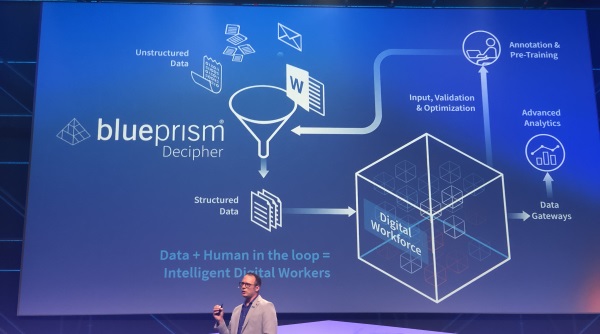
Following on from the Blue Prism World Conference in London (see separate blog), NelsonHall recently attended the Blue Prism World conference in Orlando. Building on the significant theme around positioning the ‘Connected Entrepreneur Enterprise’, the vendor provided further details on how this links to the ‘democratization’ of RPA through organizations.
In the past, Blue Prism has seen automation projects stall when being led from the bottom up (due to inabilities to scale and apply strong governance or best practices from IT), or from the top down (which has issues with buy-in and with speed of deployments). However, their Connected Entrepreneur Enterprise story aims to overcome these issues by decentralizing automation. So how is Blue Prism enabling this?
Connected Entrepreneur Enterprise
The Connected RPA components, namely Blue Prism’s connected-RPA platform, Blue Prism Digital Exchange, Blue Prism Skills, and Blue Prism Communities, all aim to facilitate this. In particular, the likes of Blue Prism Communities acts as a knowledge-sharing platform for which Blue Prism envisions that clients will access forums for help in building digital workers (software robots), share best practices, and (with its new connection into Stack Overflow) collaborate on digital worker development.
Blue Prism Skills helps in lightening the load with knowledge requirements for users to begin digital worker development. with the ability to drag and drop in AI components into processes such as any number of computer vision AI solutions.
Decipher for document processing was developed by Blue Prism’s R&D lab, and features ML which can be integrated into digital workers, and in turn can have skills such as language detection from Google dropped into the process. The ability to drag and drop these skills continues the work in allowing business users who know the process best to quickly and easily build AI into digital workers. Additionally, Decipher introduces human-in-the-loop capability into Blue Prism to assist in cases for which the OCR lacks confidence in its result. The beta version of Decipher is set to launch this summer with a focus on invoice processing.
Decipher will also factor in the new cloud-based and mobile-enabled dashboard capabilities in the new dashboard notification area which, in addition to providing SLA alerts, provides alerts when queues for Decipher’s human-in-the-loop feature are backing up.
Client example
An example of Blue Prism being used to democratize RPA is for marquee client EY. EY, Blue Prism’s fifth largest client, spoke during the conference about its automation journey. During the 4.5-year engagement, EY has deployed 2k digital workers, with 1.3k performing client work and 700 working internally on 500 processes. Through the deployment of the digital workforce, EY has saved 2 million-man hours.
In democratizing RPA, EY federated the automation to the business, while using a centralized governance model and IT pipeline. A benefit of having an IT pipeline was that the automation of processes was not a stop-start development.
When surveying its employees, EY found that the employees who had been involved in the development of RPA had the highest engagement.
Likewise, Blue Prism had market surveys performed with a partner that found that in 87% of cases in the U.S., employees are willing to reskill to work alongside a digital workforce.
Summary
There is further work to be done in democratizing RPA as part of this Connected Entrepreneur Enterprise, and Blue Prism is currently looking into upgrading the underlying architecture and is surveying its partners with regard to UI changes; in addition, it is moving aspects of the platform to the cloud, starting with the dashboarding capability. Also, while Blue Prism has its university partnerships, these are often not heavily marketed and are in competition with other RPA vendors in the space offering the likes of community editions to encourage learnings.
]]>